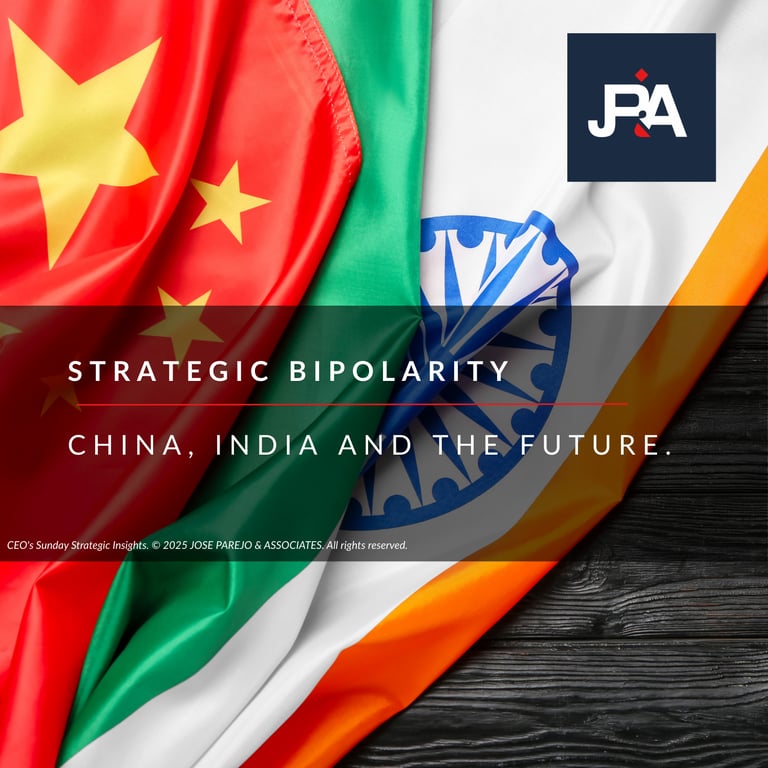

Aug 24, 2025. Beijing, Delhi and Global Gravity
Sunday CEO Strategic Insights
Where Geopolitical Analysis Meets Strategic Vision
By José Parejo, Founding Partner
Reflections on Power, Diplomacy, and Strategic Foresight
The Second Axis: How Beijing and Delhi Are Redefining Global Gravity
By José Parejo, Founding Partner, José Parejo & Associates
Empires are not built on balance sheets. They are built on corridors.
The notion of China+1 was born as a reassuring formula for risk managers and policymakers alike: reduce exposure to China, add a secondary hub, diversify the portfolio. It carried the elegance of arithmetic and the comfort of managerial logic. But history does not bend to formulas. History is a system of gravity. And gravity does not diversify — it reorders.
What is emerging today is not diversification but the quiet consolidation of a second axis. India is not “+1.” It is the other pole of a global architecture that will define the twenty-first century.
From Arithmetic to Architecture
History offers reminders that power rarely conforms to the tidy categories that institutions or managers prefer. In the nineteenth century, Britain assumed that German industrialization could be offset through alliances and naval supremacy; instead, London awoke to a rival that reordered the European balance and brought the world to war. In the Cold War, Washington and Moscow stood not as optional hedges to each other, but as systemic poles whose rivalry defined every domain — from nuclear arsenals to kitchen appliances.
Today’s illusions of China+1 belong to the same family. They assume that exposure can be neutralized by addition. Yet what is unfolding in Asia is not a hedge. It is a binary equilibrium: a gravitational order structured around two poles whose rivalry and interdependence will shape the next half-century.
Patterns of Bipolarity
For centuries, Eurasia oscillated between singular and dual centers of power. Rome and Persia contested the ancient Mediterranean and Middle East. Byzantium and the Caliphate locked the late medieval world in rivalry. London and Berlin mirrored each other in the industrial age, one a maritime empire, the other a continental challenger. Washington and Moscow defined the twentieth century in nuclear standoffs and proxy wars.
The re-emergence of a Beijing–Delhi axis is not an anomaly but a return to historical rhythm. In each case, bipolarity reshaped not only politics but commerce, finance, and technology. What is distinctive today is that the new poles are civilizational economies with the scale to dominate supply chains, digital infrastructures, and labor flows simultaneously.
Fernand Braudel observed that “events are dust; structures endure.” What we are witnessing is not an event, but the construction of a structure.
Demography as Destiny
Signals are already visible. India has overtaken China in working-age population — 995 million versus 987 million. Each year, nearly 10 million workers are added to India’s labor force, while China loses five million. By 2030, one in every four new workers in the world will be Indian. This is not a demographic trend. It is a gravitational force.
Apple now assembles more than a quarter of its iPhones in India. The calculation is not efficiency — it is geopolitical insurance. The integration of India’s digital state — identity, taxation, logistics — functions as a meta-infrastructure more coherent than that of many OECD economies. These are not isolated business headlines. They are tectonic shifts in the operating code of globalization.
Corridors, Oceans, and the Geography of Power
I recall standing at Laem Chabang port in Thailand. Trucks queued under a humid sky, feeding containers into ships bound for every corner of the Pacific. Nearly ten million containers moved through that port last year — a scale few in the West fully appreciate. A Thai official leaned toward me and said: “Every decision you make about China or India passes through here, whether you see it or not.”
That moment crystallized a truth: Southeast Asia is not a neutral passage. It is the hinge of the system itself.
The Strait of Malacca, through which almost 30% of global trade transits, is not a line on a map. It is the twenty-first-century equivalent of the Roman roads or the Silk Route — a permanent structure where commerce and power converge. Alfred Thayer Mahan warned that whoever commands the sea lanes commands global commerce. Today, corporations live this dictum daily. It is not only navies that compete over these straits, but supply chains whose survival depends on their flow.
The Indian Ocean is becoming the Mediterranean of the twenty-first century. Across its waters, from Colombo to Surabaya, the dual gravitational pull of Beijing and Delhi will define logistics, energy, and security. Braudel would have recognized it instantly: a sea not of events but of enduring structures.
The American Factor
The United States remains unmatched in finance, oceans, and security. But it is no longer a neutral stabilizer in this geometry. Washington is reindustrializing at scale, imposing tariffs that have raised hundreds of billions in revenue, and seeking to suppress China’s rise through controls on semiconductors, AI, and green technologies. Its competition is direct.
At the same time, it courts India. Yet Delhi insists on autonomy: purchasing discounted Russian energy, engaging actively with the Shanghai Cooperation Organisation, and resisting alignment on Western terms. This is not tactical hedging. It is strategic independence.
The result is not equilibrium but permanent tension: Washington competing with Beijing, reaching for Delhi, while India charts its own course.
Ibn Khaldun and the Challenge of Adaptation
The fourteenth-century historian Ibn Khaldun argued that civilizations collapse not because they are conquered, but because they fail to respond to the challenges before them. His insight resonates today. Nations that fail to adapt to this new axis will lose strategic leverage. Companies that fail to redesign their operating models will find their resilience eroded not by markets, but by corridors they do not control.
In this sense, the future corporation is no longer only a market actor. It is a geopolitical navigator, compelled to treat ports, straits, and labor flows as seriously as prices, margins, and balance sheets.
Implications for Business Strategy
Energy: The Strait of Malacca remains the artery for Middle Eastern oil and LNG flows to Asia. A disruption here would rewrite the global energy market overnight.
Technology: Supply chains for chips, electronics, and batteries are no longer anchored in “China vs. elsewhere,” but in the dual poles of Shenzhen and Bangalore.
Finance: Capital flows will oscillate between Washington’s financial command, Beijing’s state capitalism, and Delhi’s growing digital-financial ecosystem.
The boardroom is no longer a financial chamber. It is a war room for global navigation.
The Lesson for Strategy
The future is bipolar in economic substance and triangular in strategic structure. Beijing and Delhi are the gravitational poles. Washington remains the competitor that commands oceans, capital, and military reach. The geometry is unstable, but unavoidable.
Strategy today is not relocation. It is redesign. Those who understand this triad — not as balance, but as tension — will not only survive turbulence. They will define the architecture of the next half-century.
History may remember 2025 not for GDP charts, but as the year Delhi openly emerged as one of the capitals of global strategy, and the world quietly accepted that the axis of gravity no longer runs only through Washington and Beijing, but through the corridor that stretches from the factories of Shenzhen to the ports of Gujarat, across the seas that Braudel, Mahan, and Ibn Khaldun all understood in their own ways: as the structures that outlast empires.
— José Parejo
Founding Partner, José Parejo & Associates
Sunday CEO Strategic Insights | August 24, 2025
Strategic Foresight. Confidential Intelligence. Global Perspective.
© 2025 José Parejo & Associates. All Rights Reserved.
